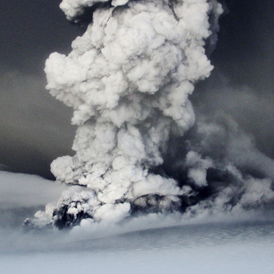UK warning over Iceland volcano flight disruption
The UK should expect some flight disruption because of the volcanic eruption in Iceland, warns the Civil Aviation Authority, as one expert also tells Channel 4 News of the risk of “glacier burst”.
The ash cloud from the massive eruption on Saturday at Iceland’s Grimsvotn volcano could reach Scotland by 6pm Monday.
Air traffic control company Nats said the latest information from the Met Office showed volcanic ash could affect some parts of Scotland between 6pm and midnight. The Met Office predicts the plume will spread to cover Ireland, Scotland, and parts of northern Britain by 6am Tuesday, and could reach some of mainland Europe by Thursday.
Asked if the cloud would cause some disruption to flights, a Civil Aviation Authority spokesperson responded: “That’s the way it’s looking certainly at the moment.”
We can’t rule out disruption. Andrew Haines, CAA Chief Executive
President Barack Obama will depart Ireland early to avoid the effects of the ash cloud.
A spokesman said: “Due to a recent change in the trajectory in the plume of volcanic ash, Air Force One will depart Ireland for London tonight.”
Andrew Haines, Chief Executive of the CAA, said: “We can’t rule out disruption, but the new arrangements that have been put in place since last year’s ash cloud mean the aviation sector is better prepared and wilƒl help to reduce any disruption in the event that volcanic ash affects UK airspace.”
Nats added that airports in the UK remained open but some services may be affected at Barra, Benbecula and Tiree airfields. Regional airline Loganair, based at Glasgow airport, has cancelled 36 flights from Tuesday. The organisation said passengers should check with their airline before travelling.

Less chaos expected
The eruption at Grimsvotn, in southern Iceland, is considerably bigger than that of Eyjafjallajokull last year, which resulted in a six-day airspace closure in parts of Europe. The ash cloud from Eyjafjallajokull cost the industry $1.7bn and forced the cancellation of 100,000 flights, disrupting 10 million passengers.
But experts say a number of factors, including a relaxation of air travel regulations for planes flying in ash and the more favourable direction of the wind, away from Europe, mean that disruption of this level is unlikely this time round.
There is also less fine ash, which spreads and travels in the air and atmosphere more easily, in the Grimsvotn plume than in last year’s eruption. But airline shares still fell between 3 and 5 per cent as the uncertainty continues.
Why Grimsvotn is not Eyjafjallajokull
Volcano experts told Channel 4 News there were a number of reasons why the eruption of Grimsvotn in Iceland would not cause the same air travel chaos as Eyjafjallajokull.
Different ash - University of Bristol's Professor Stephen Sparks said the ash from Grimsvotn was coarser, so large amounts were less likely to remain airborne until they reached the UK and mainland Europe
Different wind - "The wind pattern during the Eyjafjallajokull eruption was very unfavourable for the UK, and contributed strongly to the problem," the Open University's Dr Dave McGarvie told Channel 4 News. It's blowing the other way this time, in the main - and it might rain, which would also help.
Different rules - After criticism that the authorities were over cautious during the Eyjafjallajokull eruption, regulations have been relaxed to allow flights at certain levels of ash in the air.
Different duration - Professor Sparks said an eruption of Grimsvotn's intensity would usually die down quite quickly, meaning prolonged disruption is less likely.
Difficult to predict
Professor Stephen Sparks, at the University of Bristol, told Channel 4 News it was difficult to predict what the impact of the volcano could be, although he agreed major disruption seemed unlikely.
But he added: “It is always unwise to be certain about the behaviour of complex things such as volcanoes,” he said.
Glacier burst – and a very dramatic flood – is of some concern. This can happen quite quickly. Professor Stephen Sparks
He warned that some in Iceland were now concerned about the next stage in the eruption – “glacier burst” – and the devastating floods this event can cause. Grimsvotn is located underneath Iceland’s biggest glacier, Vatnajokull, in the south east of the country.
“Farmers on the south coast are concerned by glacier burst,” he said.
“When there is an eruption under an ice cap, that melts the glacier and the water is trapped under the cap. But then it finds its way through and you’ve got glacier burst – and a very dramatic flood – which is of some concern. This can happen quite quickly, and I would say it is quite likely here.”
However, he said that this did not mean anyone in Iceland would be in danger.
“The centre of Iceland is quite empty,” he said. “Whether this reaches where people live is different. It could flood in places where there would be no danger to people.”
-
Latest news
-
‘I violated my moral compass working for Trump,’ former lawyer testifies3m

-
Working class creatives in film and TV at lowest level in decade5m

-
Israeli police investigating attack on Gaza aid convoy4m

-
Biden announces major tariff increase on Chinese-imported green tech3m

-
‘If NHS can afford it, people with obesity should have Semaglutide,’ says weight loss expert5m

-




